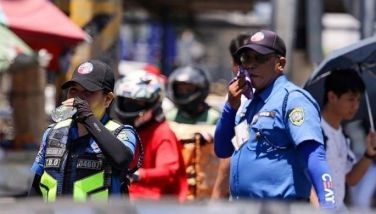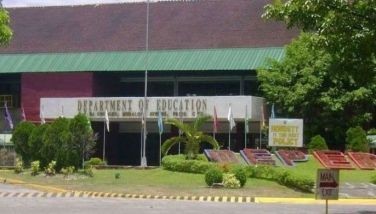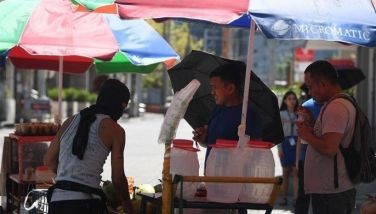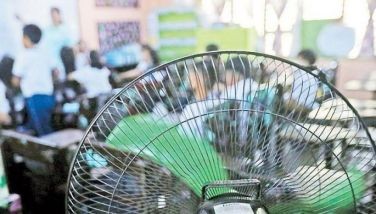Fewer registered PWD voters for 2016 elections
MANILA, Philippines – Despite efforts of the Commission on Elections (Comelec) and civil society to get eligible persons with disabilities to register, vote and do it with ease, the number of registered voters with disabilities for the May elections has slipped 14 percent from the 2013 polls.
Comelec’s “No Bio, No Boto” campaign might have led to the disenfranchisement of PWD voters, according to some disability advocates.
But others say it is possible that a number of PWDs who registered last year chose not to declare their disability because they believe they do not need special assistance on election day.
Registered voters with disabilities now total 292,908, down from 339,144 recorded in October 2013, according to a Jan. 13 report from the Comelec Elections and Barangay Affairs Department (EBAD).
The 2010 census recorded 1.443 million PWDs, or 1.57 percent of the population.
Even fewer PWDs, 37,178, manifested their desire to vote in an accessible polling place (APP) during the 2016 elections, the EBAD report showed.
The Comelec plans to designate 4,137 voting centers as APPs for this year’s elections.
Republic Act 10366 provides for APPs which, under the law, shall be located on the ground floor, preferably near the building entrance, free of physical barriers and provided with necessary services, including assistive devices.
The EBAD report covers 97.53 percent of PWD registration.Only Davao Region submitted partial results.
According to thereport, voters with physical disabilities account for 50,997 or almost 20 percent of the total number of PWD voters, followed by those with visual disabilities at 38,280.
Voters with hearing disabilities number 7,786 and those with speech disabilities, 6,857.
The Comelec has not provided an analysis of the data. Commissioner Luie Tito Guia heads the poll body’s committee on vulnerable sectors, including PWDs.
Carmen Zubiaga, executive director of the National Council on Disability Affairs (NCDA), said the decrease in the registration turnout was not so much about PWDs not wanting to take part in the elections, but about their openness to receive assistance come polling day.
She said not all PWDs indicated the need for assistance and were thus not counted as voters with disabilities.
Zubiaga also said some PWDs, such as people with learning or intellectual disabilities,were restricted by their own families from registering.
No bio, no boto
Poll watchdog Legal Network for Truthful Elections (LENTE) said, however, the decrease in the PWD registration turnout can be attributed to voter disenfranchisement resulting from the “No Bio, No Boto” campaign, which the Supreme Court upheld in December.
Republic Act 10367 mandates a biometric registration system.Voters who failed to submit themselves for validation until Oct. 31 last year will not be allowed to vote.
Validation involves digitally capturing a voter’s photograph, fingerprints and signature.
About 2.5 million voters failed to validate their biometric records during the registration period.
Disability advocate and lawyer Jessica Magbanua of Alyansa ng mga may KapansanangPinoy (AKAP-Pinoy) said not all PWDs were informed about the need to update their biometric records.
She said she is certain the poll body’s information dissemination campaign on the biometrics system failed to reach some places.
She said for most PWDs including herself, it was a case of mixed information and confusion.
“Iba-ibayungsagotnanaririnigkobefore. Pwede pa yan, bastanagpa-biometricskabefore, good pa yan. Meron din nagsasabinalahattayodapatmagpa-biometricsulit (We were given different answers. ‘You can still vote, as long as you had your biometrics taken before.’ Others say we have to get our biometrics taken again),” Magbanuasaid.
Publish names of ‘disenfranchised’ PWD voters
Magbanua urged the Comelec to release as soon as possible the names of 46,236 PWD voters who have been delisted to avoid confusion and inconvenience in the May 9 elections.
“We don’t know who among them were disenfranchised. (Comelec) should publish the names of PWDs who have been taken out of the list, so that they won’t go to the precincts anymore,” she said.
She said, however, this move should be the last resort, in case the poll body can no longer do anything to allow them to vote.
Lawyer and LENTE executive director Rona Ann Caritos said the low PWD registration turnout may be related to accessibility, such as lack of transportation.
Few PWDs sign up for accessible precincts
On January 4, Comelec Chair Andres Bautista said 209,000 PWDs and senior citizens manifested their desire to vote in an APP.
Of this number, only 17 percent or 37,178 are PWDs, according to the EBAD report.
Magbanuagave one explanation: “Kung kaya namannamin (If we can vote on our own), we would not bother the government in putting extra facilities for us.”
But the low figure also stems from the Comelec’s failure to do its part.
No PWD in the Ilocos Region and the Autonomous Region of Muslim Mindanao (ARMM) signified their intent to vote in an APP. Ilocos has 10,435 registered voters with disabilities while ARMM has 5,505.
The zero APP signup in ARMM is due to the failure of the regional Comelec to provide supplemental forms for voters with disabilities, said priest David Procalla of the Parish Pastoral Council for Responsible Voting.
Only by filling up the supplemental form, accomplished by an assistor or by the PWD, can the PWD voter indicate his or her specific type of disability and assistance he or she would need on election day.
Procallasaid the Comelec has not learned from its mistakes in the 2013 polls.
Comelec ARMM forgot to provide supplemental forms for PWDs in the region that year.As a result, registrations in Maguindanao, Lanao del Sur, Basilan, Sulu and Tawi-Tawi yielded no PWDs at all, even if these provinces do have PWD registrants.
ARMM was also the only region that did not submit any report on PWD voters in 2013, based on Comelec records at the central office.
ARMM Comelec Director Ray Sumalipaowas unavailable for comment.
In the Ilocos Region, Comelec Regional Director Noli Pipo said the zero APP signup is not necessarily a negative development.
“Perhaps it is because all polling precincts in the region are located at the ground floor of the school buildings in the designated polling centers,” he said.
“In fact, we directed our Board of Election Inspectors to avoid using the Gabaldon-type old school buildings that have five to six steps, and to choose the most accessible classrooms at the ground floor,” he added.
Comelec officials in Mindanao gave the same reason during the 2013 elections. They said they saw no need to make polling precincts more accessible since most schools were one-story.
However, VERA Files found that there were still precincts located on elevated ground that required PWD voters to climb stairs.
PWD registrants fewest in conflict areas
The top three regions with the highest numbers of PWD registrants are Eastern Visayas, 54,943 (18.75 percent); Central Visayas, 33,190 (11.33 percent); and Southern Central Mindanao, 31,297 (10.68 percent).
Meanwhile, three areas in Mindanao recorded the lowest: Northern Mindanao, 2,110 (0.72 percent); Zamboanga Peninsula,4,353 (1.49 percent); and ARMM, 5,505 (1.88 percent).
Zubiaga said PWDs in conflict-stricken areas do not usually participate, adding that there is a need for the social welfare department to strengthen its efforts in these areas to reach PWDs.
Low turnout in Metro Manila amid satellite registrations
In Metro Manila, where several satellite registrations were conducted in shopping malls since July last year, there are only 13,193 registered voters with disabilities, 47 percent of whom have expressed their intent to vote in an APP.
Amid the popularity and convenience of Comelec’s satellite registrations, some PWDs and disability advocates found the poll services lacking, even if they were given priority in queuing.
Efforts to provide sign language interpreters to assist people with hearing and speech disabilities had been rendered useless due to lack of information dissemination and coordination.
A help desk for people who are deaf and hard of hearing was provided, but was located outside of the registration area’s fences.
Such instances, coupled with bad weather, resulted in a generally low turnout of PWD registrants in Metro Manila.
Mall voting and APPs
In 2013, pro-PWD groups faulted the Comelec for failing to make the elections PWD-friendly, despite a resolution and a massive campaign for inclusiveness.
Only 23 percent, or 82,000 of the registered 362,113 voters with disabilities were able to cast their votes.
Only two out of the country’s 36,778 polling places, both in Cavite, were designated for PWDs, and most remained inaccessible, as reports from all over the country showed many PWDs and senior citizens being carried to higher floors in order to vote.
For this year’s elections, the Comelec is mulling the transfer of precincts with the most number of PWDs and senior citizens to malls to make the elections more inclusive.
Bautista, however, said mall voting is only one of the measures taken by the poll body towards accessibility.
The Comelec will run accessibility audits in public schools in coordination with the United Architects of the Philippines, Department of Education, Department of Public Works and Highways and the Department of Interior and Local Government. Ramps, railings and roads will be built to ensure that voting centers are PWD-friendly.
Even in instances where PWDs failed to declare their status, Bautista said the Comelec is exploring other options to enable them to vote without hassle.
This includes designating a PWD voting room at the ground floor of schools and assigning the Board of Election Inspectors (BEIs) to feed their ballots into the vote counting machines if the precincts are located on higher floors.
Bautista said the Comelec will also provide earphones that would allow people with visual disabilities to hear when the voting machines read their ballots.
For those with hearing disability, bigger signage will be put in all polling places to enable them to vote with ease.
Sign language interpreters will also be deployed in selected areas with big numbers of people with hearing and speech disabilities.(With Verlie Q. Retulin)
- Latest
- Trending
































